- Home
- FOR KIDS
This video will be returning shortly.
This question was posted on #PBParty today: What are 3 things every picture book writer should know? I am writing the long version of my answer today, because this is something I am passionate about. Writers have a responsibility to our readers. There are a lot of wonderful resources out there to help you develop your voice, use writing techniques, and improve your craft. But it falls short of the goal without these three components.
Number 1: Know Who You’re Writing To
More than that, don’t underestimate who you’re writing to. Picture book writers don’t just write stories for children. They write stories for everyone. The creative license is off the charts with children’s books, and it’s easy to get lost in marshmallow fluff and lose substance.
Even if the reader is 3-6 months old and likes to eat a book as much as look at it. That kid is smart. And as pieces come together, authors owe it to their audience to make pages come to life.
Number 2: Know Why You are Writing
This isn’t a question you have to ask at the beginning – but you definitely need to know the answer inside out before you submit your work for publication. What moved you to write what you did? Why did you push through?
Write about the thing that is important to you. You need a compass to complete a writing work. “Why” is a great compass.
Number 3: Know How Will it Benefit the Child/Reader
Say your answer to “why” was “because I like puppies.” I like puppies too. I’ve written about my puppy, and I had a ball doing it. But when you write about puppies, and consider thinking deeper.
Hear me out on this. We can all celebrate puppies – I’m on board. As a writer though, don’t forget you have a rare opportunity to inspire, teach, and build up brilliant young minds. Seize that opportunity.
Let them read your last page ready for more in life.
Invent your story.
My art posts tend to be encouragement-for-artists focused instead of technique-focused. That’s not intentional. In fact, I just realized I was doing it today. But I won’t apologize, and here’s why:
Above all else, artists need encouragement.
I could write to you about hatching and cross-hatching. Or share about my experiences with acrylics. We could talk for hours about photography techniques, vignettes, and stylings yet barely be dipping our toes into the sea of possibilities. And we will do that. But first…
Most of our moments are stolen by duty during the day. When moments of possibility come, it’s still hard to take them. To conquer the familiar fear of, “is this going to work?”
And we never really know.
Like the picture featured on this post. I did some work with springs. It’s quirky. It’s weird. It’s kind of funny. Kind of punny. Inventive. Odd. I mostly like it. In fact, I’m quite in love with it. But when I started, I didn’t know what the final product would become. Still, I knew when it was complete.
Risking the Rejection
My dear artistic inventors, when you’re at this point there is only one thing you can do. You must gulp – then share it. Even if it’s only with a trusted friend. At the right time, you must seize that second moment to share that small piece of you with someone new.
I read a quote by Henry Mattisse this week on Canva:
Creativity Takes Courage – Henry Matisse
It’s true. It takes courage to create, and it takes courage to create again when the first time fails. And it takes more courage to show people who just might think you’re weirder than they thought. Which might really be saying something.
Say it anyway.
Invent your story.
The world’s first computer programmer was the daughter of the poet Lord Byron. Many of us feel we are either “numbers people” or “letters people”. Ada shows us what might be lost in the balance. Brilliant in math, charming in society, and famous for her work writing “Notes” meet Ada Lovelace: the Enchantress of Numbers.
She was born in England, 1815. Ada’s childhood was similar to what we discovered with Thomas Edison, in that she suffered significant childhood illness. During her teenage years, she was introduced to Charles Babbage, a British mathematician. The “Father of computers” and Ada hit it off, and they worked together on his Analytical Engine.
“The Analytical Engine weaves algebraic patterns, just as the Jacquard-loom weaves flowers and leaves.” – Ada Lovelace
Ada had a great imagination; a quality valued by many inventors like Albert Einstein. Ada Lovelace was the first to recognize a revolutionary idea: the Analytical Engine had potential beyond crunching numbers. She published the first algorithm that could be employed by the machine, and was named (posthumously) the first computer programmer.
“I never am really satisfied that I understand anything; because, understand it well as I may, my comprehension can only be an infinitesimal fraction of all I want to understand about the many connections and relations which occur to me, how the matter in question was first thought of or arrived at, etc., etc.”
Ada’s thirst for knowledge was insatiable. Her ability to recognize and value how elements connect to one another make her an outstanding example for inventors to follow.
Whatever project you are working on or starting today, look to see how it connects to the world. Are the patterns in place that you missed the first run through? Ada Lovelace teaches us to look with eyes that not only see what is, but wonder at what could be.
(sources include but not limited to: Coding for Dummies, encyclopedia.com)
Until next time,
Invent your story
Every life is a story. Every story has a theme or purpose. In writing, sometimes an author develops a theme and then writes. Other times a theme emerges when the work is complete. In my study of Thomas Edison, who is famous for inventing the lightbulb, phonograph, and motion picture camera, a theme emerged as if it was pre-planned.
I have not failed. I’ve just found 10,000 ways that won’t work. – Thomas Edison
Perseverance
That famous quote may be the definition of what it means to press through and not give up on a goal. As an inventor holding over 1,000 patents to his name, he wasn’t throwing idle numbers around. Can you feel the fight in these words? He indignantly refused to accept any try as wasted time, and he recognized the value of each forward step.
I’d love to know where he got his grit. As a child, Thomas came down with scarlet fever, had recurring middle ear infections, and suffered hearing loss. Life didn’t come easy for Edison, but he didn’t let that stop him from inventing.
Opportunity is missed by most people because it is dressed in overalls and looks like work. – Thomas Edison
Oof! If you google Thomas Edison quotes, you’ll find he talks straight about hard work. During his young life, he sold newspapers and candy on trains. He worked for over 3 years as a telegraph operator before launching his career as an inventor. Through these years, he did experiments – that sometimes got him into trouble – and continued to try again and again.
The value of an idea lies in the using of it. – Thomas Edison
Just as we look for the theme or point of a story, Edison looked for the usefulness of the invention. He didn’t use his mind and talents to create idly and be cool. Thomas was a man who saw the needs of his generation, and worked adamantly to bring to fruition inventions that helped to meet those needs.
The result of that perseverance?
He drastically changed the world.
So, inventors, we’ve got work to do. Hike up your sleeves, or put your overalls on. And if your idea doesn’t work the first time, don’t give up!
Invent your story.
This is my second post that studies the lives of inventors. You can learn something useful (that may flip your value system) about Albert Einstein at: What You Didn’t Know You Have in Common with Albert Einstein.
I learned a lot about Thomas Edison on Wikipedia and found the cool quotes in this post at BrainyQuote. If you want to learn more about Edison, these sites a great place to start!
(sources include but not limited to: encyclopedia.com, wikipedia.com)
Until next time,
Invent your story
In your life’s journey, you may come across a pineapple picture or two. These pineapples may look different, though they are both pineapples. You might immediately have a desire to compare them. When you do, keep this in mind:
How to Compare Pineapples
Artists, writers, athletes, and pretty much anyone who does anything takes a risk. If someone enters a competition, they risk winning and losing. For artists, if they draw/paint/sculpt/design something and share it, they risk judgement.
Artists need to understand not everyone is going to value their artwork the same. Not every color or design will inspire every person. And that’s good – we live in a beautifully diverse world. But today I am speaking to the artist and the viewer of the art. The evaluator. The judge.
How do you compare pineapples?
I drew one of the pineapples in this post, and I got permission from the other artist to share his work today. We drew these pineapples in response to this challenge: draw a pineapple. We came up with very different pictures.
As people compare pineapples, often one of two thoughts can come into our heads:
One pineapple is superior.
~OR~
One pineapple sucks.
I find both of these judgements to do more damage than good. As an artist, if I think my pineapple is superior, I close myself off to learn from the mind, heart, and technique that went into creating the other pineapple. If I think my pineapple sucks, I am devaluing my work and the mind, heart, and technique I put into what I created. The critic faces the same pitfall comparing in that manner.
Instead, try comparing this way:
Value each piece of pineapple artwork respectively.
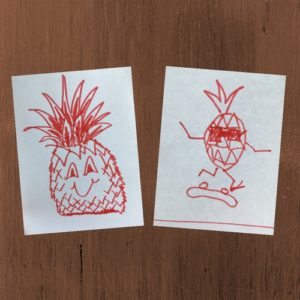
They are different. One is skateboarding. The other is sitting. One is smooth. The other is pokey. One is wearing shades. The other is smiling.
They are similar. Both pineapples have personality. Both have style. Both pineapples have faces. And they both have spikes on top.
Ask yourself: What is this celebrating? What can I learn from this? Do I want to take something from this picture, and try it when I draw my next pineapple?
Although it may feel elementary, this exercise is one of the most powerful practices both the artist and the critic can apply in life. Because once we learn how to compare our pineapples with value and respect, then can decide how to best use them. Maybe one belongs in a children’s book and the other on a T-shirt.
This is the joy of inventing art together: we can all become our best when we value and learn from our artistic differences.
Happy Inventing!
I did not come up with this idea, but I’ve seen tutorials and was curious if this odd little trick really worked. It does! If you have nail polish around the house that you want to get rid of, this is a great way to put it to use. Here’s how it works:
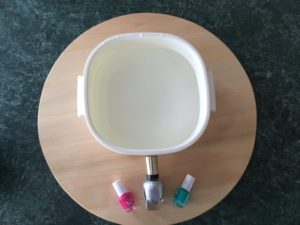
Supplies You Need:
Bowl
Stirring tool (I used a straw)
Nail Polish
Water
Object (white or clear works well) to design
Fill it!
Fill the bowl about halfway with water. You want it deep enough so there’s some distance between the surface of the water and the bottom of the bowl, so you don’t bump it. You can adjust this to your liking.
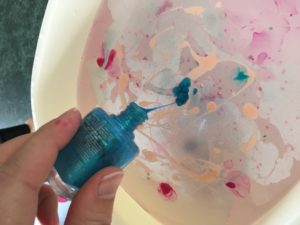
Mix it!
Take your favorite colors, and experiment. You can use as many as you want, although following a color scheme is usually a good idea. The nail polish will float on the surface of the water, and when you have the colors you want inside, go ahead and give it a stir.
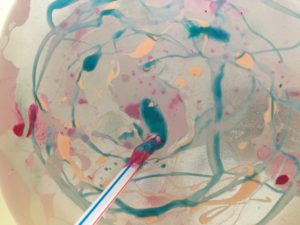
Dip it!
Now’s the fun part. Gently dip and turn your object onto the surface of the water. The nail polish will adhere to it right away! I found that all of the bowl was not covered to my liking with my first turn, so I simply put more nail polish in and did it again!
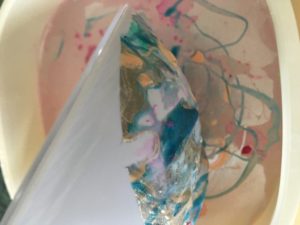
The project can get a little bit stinky and messy, but the results are fantastic. Plus, it’s a cinch to set up. This little bit of inventiveness is the perfect way to add a splash of color to your life.
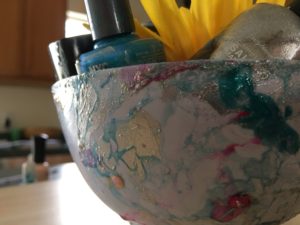
Happy Inventing!
Some mornings I don’t want to move. Coffee and the couch are my two tools to start the day. I sit, sip, and wait for help to arrive. This morning was one of those, and as I tried to wake up, I noticed something under the kitchen table.
Okay, there wasn’t a something.
There was nothing, but it looked so interesting. Cool enough for me to look twice. The overcast sky shone on my floor, creating a shadowy reflection of muted colors.
As winter slowly releases her icy grasp, one of the things I have noticed this season is the ice melting on ponds. Maybe a different time of year I would see something else, but somehow one seemed to sneak under my kitchen table long enough for me to snap a picture of it. Tall trees in cold, watery beds gave me hope that the flowers are still sleeping underneath.
I think part of being an artist is remembering to look twice. Often, something will have enough spark to catch our eye, but in the busyness of the day, take time to stop and discover it.
Maybe there’s benefit to those moments we don’t want to move.
So, my fellow lovers of all things art, here’s the takeaway:
Look twice.
Keep your camera or sketchbook handy.
Drink coffee.
Because eventually, we all need to keep moving forward. But the journey is more interesting with that picture in your pocket. And who knows what you will invent with it next?
What do you see when you look at a blank page? Do you see opposition or opportunity? Today I am going to share about a writing technique/concept. I learned this from a professor in college, and it’s something I still practice today.
First, hunt for a blank piece of paper.
It must be free from all other things: no lines, no headers, and no artwork. If you like to write on colored paper, you absolutely can – I would just say be mindful of the color. In fact, if you write a novel by hand and complete your entire rough draft on pink paper, I think that alone is interesting enough for me to want to look at the book.
Second, shut down your computer.
Your blank page cannot be on your computer screen. This must be a real-time, real-life, legit piece of paper. Size doesn’t matter. Well, depending on how many words you want to put on it, you might need more pages. But you want to have a piece of paper you can lift up, fold, smell, rip, and take with you wherever you go. Now, you’re ready to write.
Third, consider the opportunity.
Many writers avoid blank pages because we fear writer’s block. But when a child looks at a blank piece of paper, something is sparked within them. Excitement. Opportunity. They’re not constantly being autocorrected or forced into perfect spacing. They are free to press on a pen, crayon, or marker, and put into words the wonder that is inside their minds. If words don’t do it justice, a sketch here or there will fill in the gaps. It’s a beautiful, personal, and smart way to craft creative work.
There is a time and a place for the computer, typewriter, or whatever tool you want to use. They help to make your work accessible, readable, and grammatically correct. But I challenge you to a blank piece of paper today: an open world waiting for you to invent it.
As a writer, it’s important to get to know your characters as much as possible. To do this well, you might want to try writing a negative space story. So, what is a negative space story, and why is it so helpful?
Negative Space
Traditionally used in relation to art, negative space is literally the space in between and around the subject of a painting/artwork. The effect of negative space can often have dramatic results. In some cases, the subject is removed, and the negative space creates an entirely different picture than what was originally intended.
Many writers compare the act of writing to “watching a movie in your mind” and trying to describe/transcribe what is imagined. A negative space story is kind of like a deleted scene from a movie. It’s a part of the story that doesn’t make the final cut, but it serves a purpose for gaining insight into the world and characters.
I was recently challenged to write a negative space story. Here’s a great place to start: choose a minor character. On the surface, it doesn’t matter which character you choose, but prepare yourself to let it have a surprising amount of influence. Minor characters can become very interesting once you get to know them.
When I read negative space stories, it changes the way I think about books.
See the value of every character in the story, not just the main ones.
Take the time to write things that won’t make the final cut. It enhances the journey.
Be open to where the rabbit hold may lead.
I wrote a flash fiction piece not long ago that I intended for exactly that purpose: a very short story. Then I met the characters, and there’s more to them than I thought. As I’ve worked on their negative space story, I found myself jumping into a genre I’ve never explored before. It’s exciting!
Here’s to your writing journey and invaluable negative space.
Invent your story!
